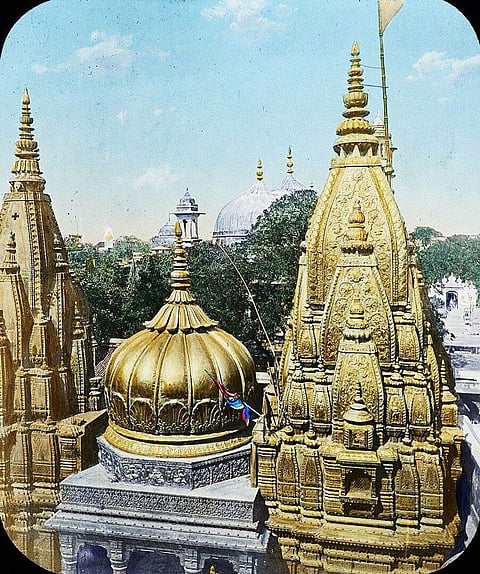
- Home
- न्यूजग्राम
- NewsGram USA
- India
- World
- Politics
- Entertainment
- Culture
- Lifestyle
- Economy
- Sports
- Sp. Coverage
- Misc.
- NewsGram Exclusive
- Jobs / Internships

During clearing process of "Kashi Vishwanath Dham Corridor", over 40 ancient temples were discovered in Kashi. The temples are said to have historic and religious significance as per 'Kashi Khand of Skand Puran'. The temples which were found hidden behind the wall of buildings of Kashi strike questions over the brutalised history of Kashi. Manisha Inamdar in her article for News Bharati comes up with questions like- Were these temples hidden by overlaying constructions to protect from desecration and destruction by foreign invaders? Or they were illegally occupied for generations? If it was the case of encroachment, why the recovered temples are still safe and intact?
Kashi Vishwanath Temple is one of the most famous Hindu temples and the holiest of Shiva Temples. Located in Varanasi, Vishwanath Temple is one of the twelve Jyotirlingas and stands on the western bank of the holy river Ganga in Kashi. The temples were found under "Kashi Vishwanath Dham Corridor" project which is an ambitious flagship programme of Prime Minister Narendra Modi in his Lok Sabha constituency Varanasi. The idea behind this project is is to end the hardships of devotees by easing the traffic and movement of people around the temple and providing good facilities to the the people visiting the temple.
Follow NewsGram on Quora to get answers to all your questions.
Kashi is the land where Goswami Tulsidas spent most of his life. Wikimedia Commons
Kashi, Varanasi, Benares, are the three different names of the same city, denoting different era's of history of Kashi. Kashi consisted of great scholars, sages, saints, philosophers, etc. Kashi is the land where Goswami Tulsidas spent most of his life and wrote Ramcharitamanas while travelling to Ayodhya and Kashi frequently, the land where Adi Shankaracharya wrote Manisha Panchakam, where four of Jain Tirthankaras Suparshvanath(7th), Chandraprabhu(8th), Shreyanshnath (11th) and Parshvanath(23th) Tirthankaras were born, where Guru Gobind Singh sent the five Sikhs to study Sanskrit and later their teachings came to be known as the Nirmala Sikhs and the place where Mahamana Madan Mohan Malviya founded Banaras Hindu University.
Archeological excavations of Kashi prove it to be more than 8000 years old whereas the documented golden history of the city is of more than 3500 years. In anciuent times, Kashi was also subjected to subjected to death and destruction.
The city of Kashi was ravaged countless number of times by foreign invaders while Indians had rebuilt it after its destruction. The original Vishwanath temple was destroyed in 1194 by Qutb-al-din Aibak Mohammad, who was commander of Mohammad Ghori. The temple was rebuilt by a Gujarati merchant after 100 years. The temple was again demolished in 1447 by Mahmud Shah, the Sultan of Jaunpur. The temple was again rebuit in 1585, at it's original site by Raja Todarmal. Shah Jahan, in 1632, had passed the order to demolish Kashi Vishwanath Temple. However, his armies were not succcessful in destroying Kashi Vishwanath Temple due to strong opposition from the Hindus, but succeeded to demolish 63 other temples in Kashi.
Aurangzeb issued a decree ordering the demolition of Kashi Vishwanath temple on 18 April 1669. This decree is still preserved at the Asiatic Library, Kolkata. Aurangzeb demolished the temple in September 1669 and the Gyanvapi Mosque was built at its place. The remnants of the ancient Kashi Vishwanath Temple can be seen on the walls of the Gyanvapi mosque even today. The walls of the original temple openly display significant portions on the mosque. The current temple was built on an adjacent site by Ahilya Bai Holkar, the Maratha ruler of Indore in 1780.
Fortunately, over 40 temples with architectural marvels have been recovered intact from Kashi. Wikimedia Commons
There is also a small well in the temple known as Gyaan vapi (the wisdom well). It is believed that the main priest of the temple jumped into the well with Jyotirlinga to protect it from invaders.
Fortunately, over 40 temples with architectural marvels have been recovered intact from Kashi.
Demolition of heritage is an easy way to destroy the civilizations of nation. This is how foreign invaders tried to demolish our civilisation. History is a great teacher. Those who do not learn from history, those who do not remember their past are condemned, are destined to repeat the same mistakes. Discovery of more than 40 ancient temples are concrete proof of our history which is described and dismissed as mythology. It is high time to connect people of India with their glorious past as these concrete proofs are screaming out to be our glorious history says Manisha Inamdar in her article for News Bharati.
